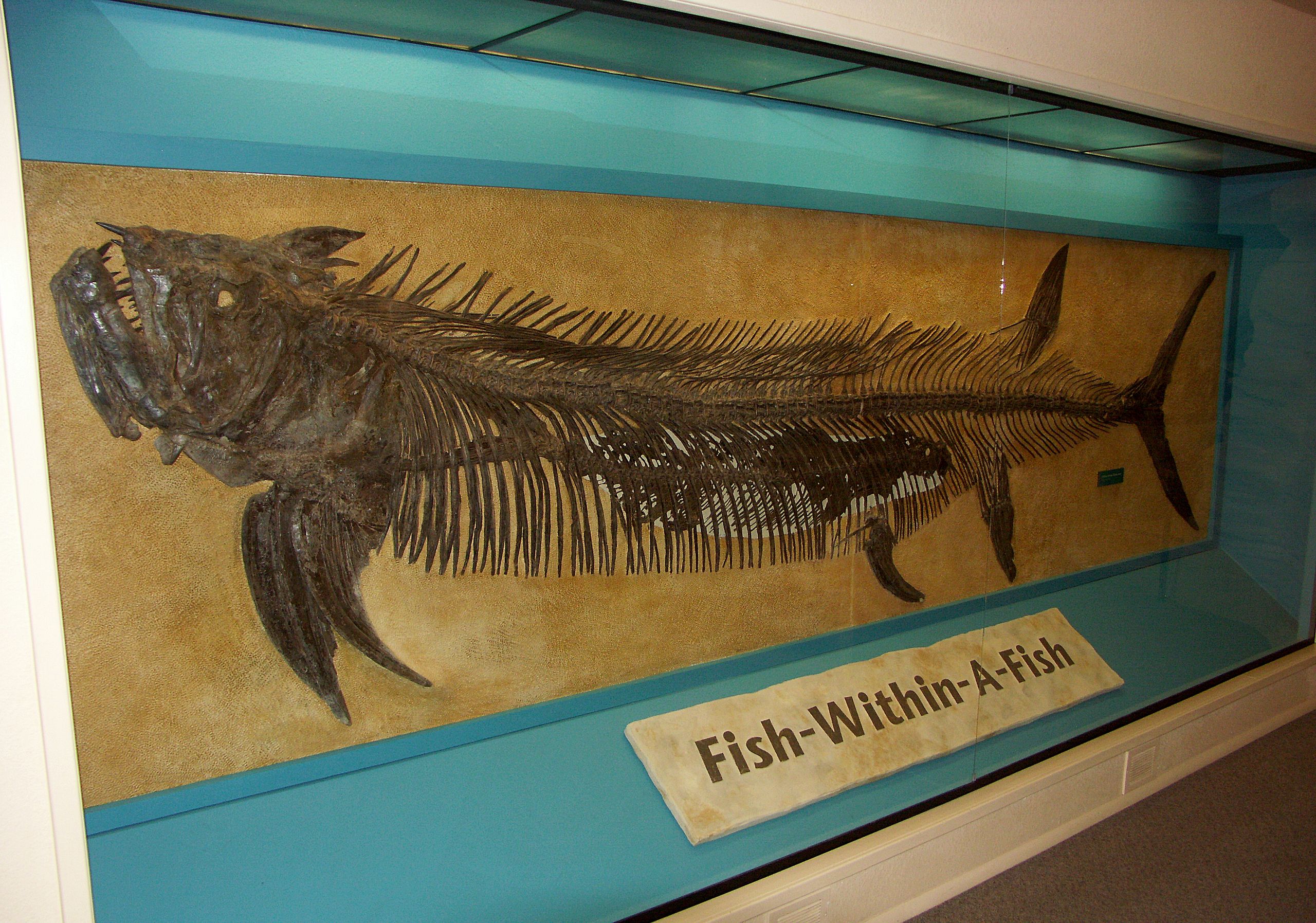|
Saurodontidae
Ichthyodectiformes is an extinct order of marine stem-teleost ray-finned fish. The order is named after the genus '' Ichthyodectes'', established by Edward Drinker Cope in 1870. Ichthyodectiforms are usually considered to be some of the closest relatives of the teleost crown group. They were most diverse throughout the Cretaceous period, though basal forms like ''Thrissops, Occithrissops'' and ''Allothrissops'' are known from the Middle-Late Jurassic of Europe and North America. Most ichthyodectiforms ranged between 1 and 5 meters (3–15 ft) in length. Most of known taxa were predators, feeding on smaller fish; in several cases, larger ichthyodectiforms preyed on smaller members of the order. Some species had remarkably large teeth, though others, such as ''Gillicus arcuatus'', had small ones and sucked in their prey. '' Heckelichthys preopercularis'' is a rare example of non-predatory ichthyodectiform, more likely to be microphagous, fed on small particles. There is evidenc ... [...More Info...] [...Related Items...] OR: [Wikipedia] [Google] [Baidu] |
Xiphactinus Audax
''Xiphactinus'' (from Latin and Greek for "sword-ray") is an extinct genus of large (Shimada, Kenshu, and Michael J. Everhart. "Shark-bitten Xiphactinus audax (Teleostei: Ichthyodectiformes) from the Niobrara Chalk (Upper Cretaceous) of Kansas." The Mosasaur 7 (2004): 35-39.) predatory marine bony fish that lived during the Late Cretaceous (Albian to Maastrichtian). Species in the genus bore a superficial resemblance to a gargantuan, fanged tarpon. The species ''Portheus molossus'' described by Cope is a junior synonym of ''X. audax''. Skeletal remains of ''Xiphactinus'' have come from the Carlile Shale and Greenhorn Limestone of Kansas (where the first ''Xiphactinus'' fossil was discovered during the 1850s in the Niobrara Chalk),''Xiphactinus'' at |
Middle Jurassic
The Middle Jurassic is the second epoch of the Jurassic Period. It lasted from about 174.1 to 163.5 million years ago. Fossils of land-dwelling animals, such as dinosaurs, from the Middle Jurassic are relatively rare, but geological formations containing land animal fossils include the Forest Marble Formation in England, the Kilmaluag Formation in Scotland,British Geological Survey. 2011Stratigraphic framework for the Middle Jurassic strata of Great Britain and the adjoining continental shelf: research report RR/11/06 British Geological Survey, Keyworth, Nottingham. the Daohugou Beds in China, the Itat Formation in Russia, and the Isalo III Formation of western Madagascar. Paleogeography During the Middle Jurassic Epoch, Pangaea began to separate into Laurasia and Gondwana, and the Atlantic Ocean formed. Eastern Laurasia was tectonically active as the Cimmerian plate continued to collide with Laurasia's southern coast, completely closing the Paleo-Tethys Ocean. A subduction zone ... [...More Info...] [...Related Items...] OR: [Wikipedia] [Google] [Baidu] |
Allothrissops
''Allothrissops'' is an extinct genus Genus ( plural genera ) is a taxonomic rank used in the biological classification of extant taxon, living and fossil organisms as well as Virus classification#ICTV classification, viruses. In the hierarchy of biological classification, genus com ... of bulldog fish. References Prehistoric ray-finned fish genera Ichthyodectiformes {{Paleo-rayfinned-fish-stub ... [...More Info...] [...Related Items...] OR: [Wikipedia] [Google] [Baidu] |
Basal (evolution)
In phylogenetics, basal is the direction of the ''base'' (or root) of a rooted phylogenetic tree or cladogram. The term may be more strictly applied only to nodes adjacent to the root, or more loosely applied to nodes regarded as being close to the root. Note that extant taxa that lie on branches connecting directly to the root are not more closely related to the root than any other extant taxa. While there must always be two or more equally "basal" clades sprouting from the root of every cladogram, those clades may differ widely in taxonomic rank, species diversity, or both. If ''C'' is a basal clade within ''D'' that has the lowest rank of all basal clades within ''D'', ''C'' may be described as ''the'' basal taxon of that rank within ''D''. The concept of a ' key innovation' implies some degree of correlation between evolutionary innovation and diversification. However, such a correlation does not make a given case predicable, so ancestral characters should not be imputed to th ... [...More Info...] [...Related Items...] OR: [Wikipedia] [Google] [Baidu] |
Endotherm
An endotherm (from Greek ἔνδον ''endon'' "within" and θέρμη ''thermē'' "heat") is an organism that maintains its body at a metabolically favorable temperature, largely by the use of heat released by its internal bodily functions instead of relying almost purely on ambient heat. Such internally generated heat is mainly an incidental product of the animal's routine metabolism, but under conditions of excessive cold or low activity an endotherm might apply special mechanisms adapted specifically to heat production. Examples include special-function muscular exertion such as shivering, and uncoupled oxidative metabolism, such as within brown adipose tissue. Only birds and mammals are extant universally endothermic groups of animals. However, Argentine black and white tegu, leatherback sea turtles, lamnid sharks, tuna and billfishes, cicadas, and winter moths are also endothermic. Unlike mammals and birds, some reptiles, particularly some species of python and tegu, pos ... [...More Info...] [...Related Items...] OR: [Wikipedia] [Google] [Baidu] |
Gillicus Arcuatus
''Gillicus'' was a relatively small, 2-metre long ichthyodectiform fish that lived in the Western Interior Seaway, in what is now central North America, during the Late Cretaceous. Description Like its larger relative, ''Ichthyodectes ctenodon'', ''Gillicus'' had numerous small teeth lining its jaws, and ate smaller fish by sucking them into its mouth, but the teeth of ''Gillicus'' are so small that the jaws appear almost toothless at first, which has led to the suggestion that ''Gillicus'' was also a filter-feeder. ''Gillicus'' was also eaten by its own relative, ''Xiphactinus''. One particular long fossil specimen contains a nearly perfectly preserved long ''Gillicus arcuatus'' inside its ribcage. The ''Gillicus'' bones have not been digested so the larger fish must have died soon after eating its prey. The cause of death may have been due to injuries, such as a ruptured major blood vessel, caused by the fin of the smaller fish as it struggled while being swallowed. This fo ... [...More Info...] [...Related Items...] OR: [Wikipedia] [Google] [Baidu] |




